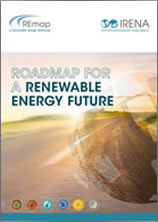REmap: Roadmap for a Renewable Energy Future, 2016
REmap determines the realistic potential for countries, regions and the world to scale up renewables in order to ensure an affordable and sustainable energy future.
REmap is unique in that is assesses worldwide renewable energy potential assembled from the bottom up, starting with separate country analyses done in collaboration with country experts, and then aggregating these results to arrive at a global picture.
The analysis encompasses 40 countries representing 80% of global energy use. The roadmap focuses not just on renewable power technologies, but also technology options in heating, cooling and transport.
In determining the potential to scale up renewables REmap focuses on possible technologies pathways and assesses numerous other metrics, including: technology, sector and system costs; investment needs; externalities relating to air pollution and climate; CO2 emissions; and economic indicators such as employment and economic growth.
Based on these country driven results, REmap provides insights to policy and decision makers for areas in which action is needed.
Some of the key findings from the 2016 edition of the REmap global report include:
- REmap finds that doubling the share of renewable energy by 2030 saves up to USD 4.2 trillion annually – 15 times higher than the costs – thanks to avoided expenditures relating to climate change and air pollution.
- Significantly scaling up renewables is feasible and affordable, it would result in lower overall costs, save millions of lives due to lower air pollution, increase economic growth and employment, and set the world on a pathway to limiting temperature rise to 2 degree Celsius or below when combined with increased energy efficiency.
- Business-as-usual will only result in an increase of this share from 18% in 2010 to 21% by 2030.
- A doubling would achieve up to 12 gigatonnes of energy-related CO2 emission reductions compared to the Reference Case in 2030. This is 5X higher than what countries have pledged to reduce through renewable energy in their NDCs. When coupled with improvements in energy efficiency, it would reduce emissions enough to set the world on a pathway to limit global temperature rise to 2 degrees above pre-industrial levels, as called for in the Paris Agreement.
- There are also important macro-economic benefits. Doubling the renewable energy share would result in 24.4 million jobs in the renewable energy sector in 2030, compared to 9.2 million in 2014.
- Despite falling prices of fossil fuels, investments in renewable energy continue to increase: 2015 was a record year for solar photovoltaic and wind power installations.
Details
- Source: International Renewable Energy Agency (IRENA)
- Source Link: http://www.irena.org
- Publication Date: 03/2016
- Country: United Arab Emirates
- Language: English
